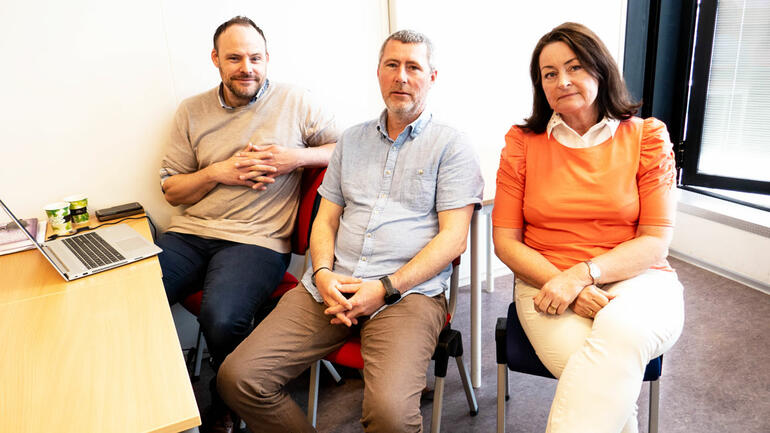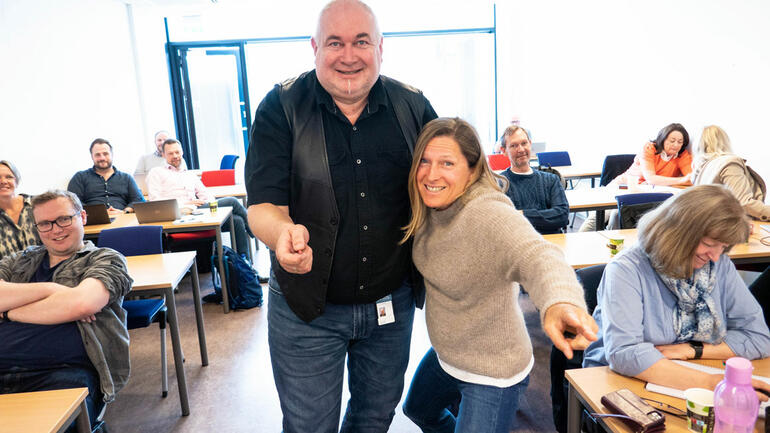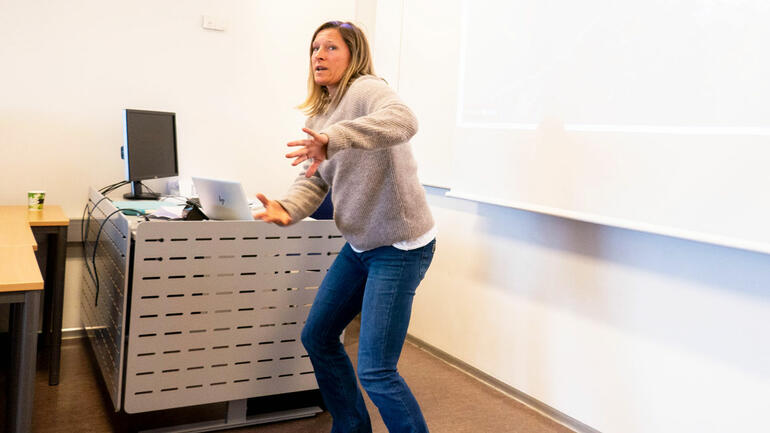They work in Vy (the national Norwegian railway company), Nav (the Norwegian Labour and Welfare Administration), child protection, emergency services and various public organizations and companies and can experience situations they are not prepared for. That means, now they are perhaps a little better prepared than they were.
– In the last two years, we have learned that unforeseen events can hit us hard both as individuals, workplaces and society. We have experienced that some unforeseen events can be short-lived, and others long-lasting such as the pandemic. It requires knowledge and expertise to handle these challenges over time, say Håvard Dahl Haugen, Frode Vestgarden, Anne Lie Andreassen and Kjetil Landro.
They are students at the University of South-Eastern Norway (USN) on the postgraduate and further education course "The Unforeseen and Preparedness", which they inaugurated simply called the UN study. The campus-based study takes place on the Drammen campus, where we will meet the students at one of the last gathering in spring 2022.
READ ALSO: Researchers: - The corona pandemic has common features with war
Demanding moments on the ski slope
Here they get a rather different lecture with former telemark skier, alpine skier and ski cross athlete Hedda Berntsen. Among other things, she has Olympic silver and X-Games silver in ski cross, WC gold in telemark skiing and WC bronze in slalom. Now Hedda Berntsen is an associate professor at USN, and tells about some demanding moments on the ski slopes.
She shows a video from the X-Games. It goes very fast, and the distance between the athletes is small. Suddenly one fell, right in front of Hedda and right before a turn.
– Here I have to make a few choices in the course of hundredths of a second, and I experience having completely conscious thoughts in this situation. I considered both braking, driving on top of the skier who fell on the turn, or driving straight in front of one of the others to reach the finish line first. I remember thinking: OK, I have to get into the turn, but without driving into one of the others. That's why I went into a skid.

Berntsen goes into a kind of hockey position in front of the students, and in the blink of an eye she seems to be back on the ground again. She says she is convinced that it is possible to think and make rational choices, even if she only has a few hundredths of a second. But that requires you to be prepared for unexpected things to happen.
– This is an ongoing discussion within the sports field. In other words, the extent to which one has the ability to think and make informed choices in such situations
Unforeseen events may occur
Berntsen has had the experience of making it happen several times, but it has not happened by itself. It is a result of training, visualizations and that she has taken seriously that unforeseen events can occur.
– My biggest fear is coming onto a jump and noticing that I end up behind while I'm in the air. That's why I've practiced a backwards somersaults while training in the water. It is now programmed into my body, because falling backwards and being able to end up on my back is my nightmare.
She talks about how research has shown that it is not a matter of course that the good feelings make you perform at your best.
– The times I have performed best, it has been uncomfortable and painful.
Then she shows the students how she can quickly get into what she calls her optimal performance zone. With the help of breathing, body movements and slapping her face and body, she boosts the adrenaline and gets focus.
– I can get into this zone in two seconds. Because I have trained for it, says Hedda.
Terrorist incidents on trains
The students in the classroom are not top athletes, but they can find themselves in situations they are not prepared for.
– In our jobs, we are in the marginal zone of the rescue work. Often, the main focus of preparedness can be to prevent something from happening or to solve incidents in the best possible way while they are happening. In our group, we have also been preoccupied with what happens afterwards when the smoke has settled. Preparedness is also about how we as a society take care of those who are affected by unforeseen events, say Håvard, Frode, Anne Lie and Kjetil.
In the project they have collaborated on, they have looked at terrorist incidents on trains. They have gone through experience reports from two well-known terrorist incidents on trains and subways: Madrid in 2004 and London in 2005, as well as the report from the 22 July commission.
– The case is relevant for Kjetil, who works in Vy as a locomotive driver, and Frode, who works in a technical department in Drammen municipality. Terror has as its basic aim to create fear in the population, and from research we know that such incidents cause people both serious short-term and lasting health problems. The case is therefore also relevant for Håvard, who meets the victim in his job at Nav, and Anne Lie, who works with research on survivors and victims after violence and trauma, they say.

– Any aha experiences in your studies? Issues you haven't thought about before?
– The importance of interaction. Some of us primarily work with preparedness internally within our own organisation. It is about, among other things, communication, trust, a learning culture and training. Those who work with preparedness in different agencies on a daily basis know this. The aim of the study has been for us to develop new knowledge and expertise in our respective workplaces.
– Will this education change the way you relate to preparedness?
– Yes absolutely. It is just as important to focus on good interaction and good practice arenas as it is to train on the more traditional fire drills. As a group, we represented four very different workplaces and areas of expertise. In the group work, we used everything we have learned about interaction during the course. None of us work on a day-to-day basis with efforts/rescues. The study has therefore given us new tools and a perspective on preparedness.
